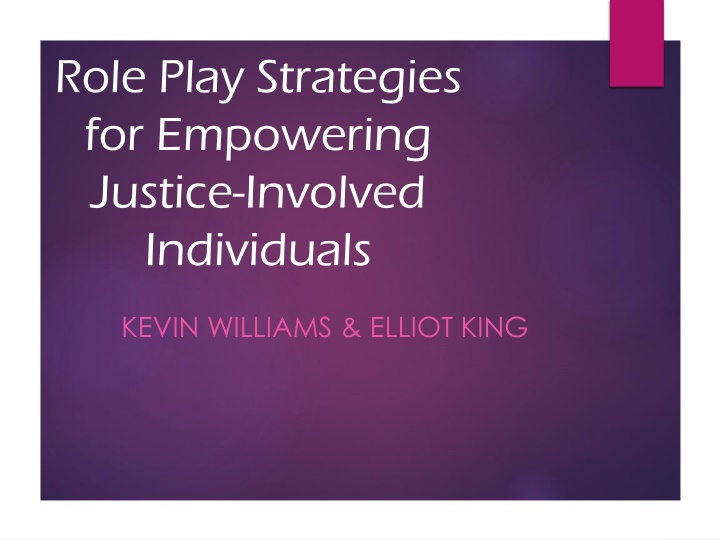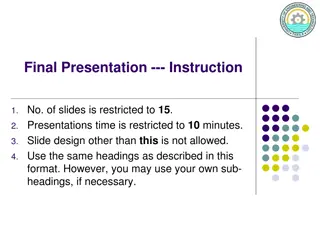
Empowering Justice-Involved Individuals Through Role-Play Strategies
Explore role-play strategies for empowering justice-involved individuals by addressing social challenges, utilizing rehabilitative tools, and implementing evidence-based practices. Enhance skills through structured learning procedures and cognitive behavioral theory to support successful reintegration and reduce recidivism.
Download Presentation

Please find below an Image/Link to download the presentation.
The content on the website is provided AS IS for your information and personal use only. It may not be sold, licensed, or shared on other websites without obtaining consent from the author. If you encounter any issues during the download, it is possible that the publisher has removed the file from their server.
You are allowed to download the files provided on this website for personal or commercial use, subject to the condition that they are used lawfully. All files are the property of their respective owners.
The content on the website is provided AS IS for your information and personal use only. It may not be sold, licensed, or shared on other websites without obtaining consent from the author.
E N D
Presentation Transcript
Role Play Strategies for Empowering Justice-Involved Individuals KEVIN WILLIAMS & ELLIOT KING
Program Goal Participants will review and practice how to conduct role plays in group settings, individual meetings and daily interactions.
Objectives o To list the unique social challenges faced by former offenders. o To illustrate the benefits of role-playing as a rehabilitative tool. o To prepare participants with practical evidence-based strategies for implementing role-playing in support programs.
Structured Learning Procedure
CBT Social Learning Theory Cognitive Behavioral Theory Structured Learning Procedure
Transfer of Training Provide Feedba ck Role Play Model Skill
Evidenced Based Practices Recidivism
Why do we Role Play? It is evidence based! We can work on it in a controlled environment. Systemic Approach. Practice makes perfect!
Identifying Skills What types of skills are important ? How do I identify skills? Where can I find this information ?
Curriculum Driven Based on past behavior Forecasting a Future Need
What types of skills are important? Criminogenic Needs Anti-social attitudes, values, and beliefs Anti-social peers Anti-social personality Family Neighborhood Education Employment Financial Substance Abuse
Where can I find this information? ORAS Case Notes Conversations Observation
How to Role Play (group setting) 1. Participants identify future based situations where they can practice the skill. 2. Select a main actor to come up. 3. Main actor selects a co-actor. 4. Have the main actor paint the scene . 5. Assign steps to the class to watch for (thinking steps &action). 6. Conduct the role play 7. Provide feedback in the following order: Co-actor Class Main Actor Facilitator 8. If done perfectly, participant is done and you move on to the next person. 9. Transfer of training: Finally, participants are assigned homework for transfer of training.
Asking Questions 1. Decide if you are in a situation that might get you into trouble. 2. Decide if you want to get out of the situation. 3. Tell the other people what you decided and why. 4. Suggest other things you might do. 5. Do what you think is best for you.
How to Role Play (1 on 1) 1.Identify a skill or behavior that the client would benefit from practicing. 2.Set up the role play. Gather background info to make it realistic. 3.Complete the role play. 4.Provide feedback to the client. Ask client for their feedback (how did it feel, would it work, is it realistic?) Provide your feedback (what went well, where they could improve) 5.If necessary, repeat role play for them to incorporate feedback.
Responding to Anger 1. Listen to the person who is angry 2. Try to understand what the angry person is saying 3. Ask him/her to explain anything you don t understand 4. Show that you understand why he/she feels angry 5. In a pro-social way, express your thoughts and feelings about the situation
Time to Practice!
Exercise Break into groups of three one observer, one client, and one staff member. The staff member should have a discussion with the client using the steps for conducting a role play (1 on 1). Use one of the charted scenarios as the basis of the interaction. Once the first staff receives feedback from the observer, rotate roles until every person has had an opportunity to be the staff member.
Summary Role plays help clients, through social learning process, to learn and practice new skills. Role plays allow staff to assist clients, while also expanding upon their own skill sets and aiding in their professional growth. By improving our skill sets as staff, we increase our ability to impact recidivism.





















